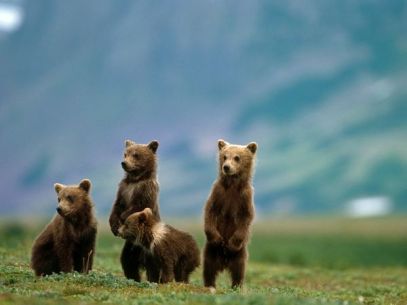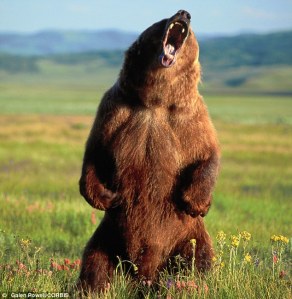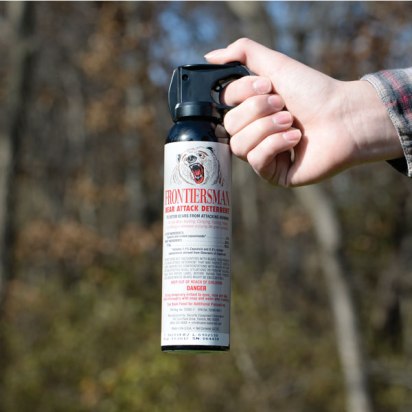Are you bear aware?
While on some trails, you might be walking through grizzly or black bear habitat. You should be prepared, knowing how to avoid conflicts with bears and what to do if that occurs. Although it’s unlikely, a bear attack could definitely ruin your day. Humans are a bigger threat to bears, and in most cases they just want to avoid you. But on the rare chance that something happens, being prepared could save your life.
Since bears very rarely hunt humans, most bear attacks are the result of humans surprising the animal and making it feel threatened. There are several things you can do while in bear country that might help you avoid surprising these powerful animals:
- Research the bear situation in the area you will be hiking, especially area closures.
- While on the trail in bear country, talking loudly, singing, clapping, and other noise-making will help alert bears to your presence, and they will generally leave the area to avoid you. Be especially loud when it is windy or you are near a creek as the noise might make it hard to hear you. In my experience, bear bells are not loud enough or very helpful. Your voice helps you be identified as human.
- Travel with a few people. Statistically, the bigger your group, the less likely you are to be attacked.
- Avoid hiking at dawn, dusk, or night. Bears tend to be more active during those times.
- If you see an animal carcass laying on the ground, try to leave the area as quickly as possible, as bears will fight to protect their food sources and might be hanging around.
What do you do if you encounter a bear? If you see a bear before it sees you, you will want to quietly and calmly leave the area. It’s best to detour far behind and downwind of the bear. If the bear does see you, never ever run. You will trigger a chase response, and it will outrun you. Don’t yell or make sudden movements. Climbing a tree is generally not a good idea because bears can climb and are faster than you. If the bear hasn’t charged you, it’s best to slowly back away while speaking in a calm, low, monotonous voice.
There are two types of bear attacks: the extremely rare predatory attack, and the more common defensive attack. In a defensive situation, the bear sees you as a possible threat to itself or its young. It might growl or clack its teeth or huff or paw the ground. These are warning signs that it feels threatened. It does not want to confront you but wants to neutralize any threat and leave. In a predatory attack, the bear might stalk you with its ears up and head erect. It will not use the warning signs I described. If a bear attacks you in a predatory manner, you may need to act aggressively and fight for your life. If the bear is being defensive, you should not fight back.
If a bear charges you after showing signs of defensiveness, stand your ground. Do not run. It will often veer off the charge. This is a great time to use bear spray, which I will get to in a moment. Don’t play dead until the bear is right about to make contact. When it does, you should lay on your belly, with your hands clasping the back of your neck. Leave your backpack on to shield your back if you have one. Try to use your elbows and toes to avoid being flipped over, and if you do get flipped over, continue to roll till you are back on your belly. At this point, you just stay still until the bear leaves. At which time you quietly retreat.
While a bear is charging, your best bet is to use bear spray (though there are no guarantees). Bear spray is made from capsicum peppers and is like pepper spray on steroids. You should have the spray in its holster ready for action. You won’t have time to grab it if it is in your pack. When the bear is still about 30-60 feet away, remove the safety clip, aim slightly downward, and spray so that a cloud is created that the bear must pass through. It helps if the wind is not blowing back into your face! Keep spraying till the bear changes direction. Then you will want to slowly back away and leave the area.
Grizzly and black bears are beautiful animals that play an important part in local ecosystems. If you are careful and prepared, it is very unlikely that you will face a problem. Attacks are often the result of a lack of education about bear safety practices. Do your research and be prepared! Happy trails.
OTHER NOTES
When you hike on federal land (like a national park) check to see if certain areas are closed for bear management. You should report any encounter with a bear to a park ranger as quickly as possible.
Note that I have only covered hiking in this post. If you plan on camping in bear country, there are additional precautions you must take. Research these before you go.
Most of this information is available on the websites for Yellowstone and Grand Teton National Parks. I recommend checking it out.
Disclaimer: I am not a wildlife expert, a safety expert, a legal authority, or an expert on bears. I do have some experience and knowledge that may prove helpful, but this site should not be seen as a source of professional or expert advice on bear safety. I claim no legal responsibility for the accuracy of this post (some information could be mistaken or outdated) or the consequences of the use or misapplication of the information in this post. Your safety is your responsibility. Above all, be aware of and heed local regulations and advice of legal authorities.
Image Credit:
Bear Cubs: http://travel.nationalgeographic.com/travel/national-parks/katmai-national-park/
Growling Bear: http://www.dailymail.co.uk/news/article-2194244/Denali-National-Park-Hiker-Richard-White-close-grizzly-bear-attack.html
Bear Spray: https://www.sabrered.com/pepper-spray/frontiersman-bear-spray-92-oz


